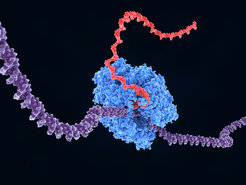The missing link
Chromatin binding protein emerges as a key regulator of transcription at genes and their control elements
In their latest study in Nature Communications, the Mayer lab has revealed that the protein BRD4 could be the regulatory link between the RNA polymerase II-mediated transcription of genes and control elements called enhancers.

Without RNA polymerase II (Pol II), the flow of genetic information from DNA to RNA to proteins is disrupted, and virtually all cellular processes stop. In a process known as transcription, Pol II converts the genetic code from a DNA template into mRNA molecules that are used for protein synthesis. While Pol II is the workhorse of transcription, its activity is also controlled by regulatory DNA elements, including enhancers. Enhancers are DNA sequences that amplify the expression of specific genes. They are often located far from the genes they control, and are themselves transcribed by Pol II. An important question is how transcription of enhancers is controlled and coupled to their target genes. Andreas Mayer's lab has previously found out that the protein BRD4 is a key regulator of Pol II at target genes, specifically in the phase of transcription known as transcription elongation, during which mRNA molecules are synthesized along a strand of DNA. "In our current study, we broadened our scope and examined Pol II regulation on a larger scale," explains Andreas Mayer. "We can now show that BRD4 plays an important role in controlling both the transcription of enhancers and the transcription of target genes."
New method with higher sensitivity
The research team used a method called NET-seq to profile the exact position of active Pol II along the genome. NET-seq is able to capture RNA as it is being synthesized at high resolution. They now improved the sensitivity of NET-seq, which helped to reveal even lowly transcribed genomic regions, where enhancers are often found. With this increased sensitivity, they were able to identify previously unknown putative enhancers in human cells. To understand how enhancer transcription is regulated and potentially linked with target gene transcription, the scientists focused on BRD4 because they found that BRD4 localizes to enhancers and genes. To elucidate the role of BRD4 at the transcribed enhancers, the team then rapidly degraded the protein and tested the immediate effect on enhancer and gene transcription. "We previously saw that BRD4 controls Pol II transcription elongation at specific genes. With the improved method we now observe that in cells lacking BRD4, transcription elongation collapses not only at the vast majority of genes, but also at enhancers, showing that BRD4 plays a larger role than previously known," explains Annkatrin Bressin, who is one of the first authors of the study. Interactions between enhancers and target genes were also reduced in BRD4-depleted cells, suggesting that the protein may also mediate these important connections.
BRD4 as a transcriptional regulator and potential therapeutic target
"Much of transcriptional regulation is often thought to occur at the initiation of transcription at which Pol II is recruited to the gene and begins with RNA synthesis. Our results now show that an important control point also happens at later stages, and that BRD4 is a central switch in the regulation of Pol II transcription elongation," says Andreas Mayer. BRD4 is a member of a larger protein family called the BET bromodomain proteins. The scientists now plan to extend their research to the other proteins in this family to understand their specific roles and whether the interactions between BET proteins influence transcription. BRD4 is also known to be an important driver of disease. In many forms of leukemia, BRD4 is associated with increased expression of oncogenes. As a result, BET inhibitors are currently being evaluated as potential drugs. "We hope that a better understanding of the specific functions of BET proteins in human cells will help to clarify their role in disease systems, which may open up improved treatment strategies in the future," concludes Andreas Mayer.












